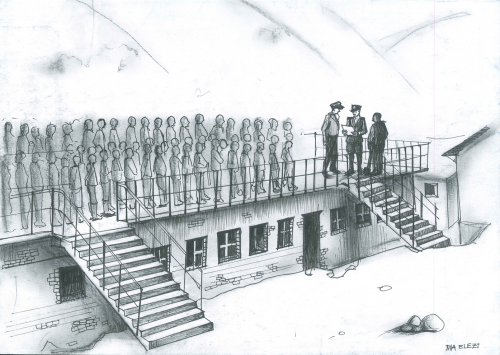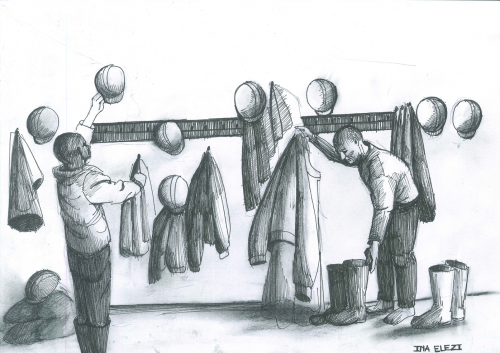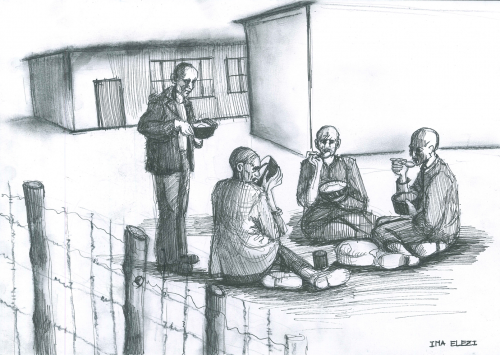

Based on rare images that managed to film the area after the fall of the dictatorship at the beginning of the ‘90s, Spaç Camp looked like this. The last political prisoners left the camp in June 1990.


In the first years of Spaç Camp’s operation, roll call was done at the area in front of the sleeping rooms and craftsman’s barracks. Later, it was done on top of the recently built toiletroom.The sketch shows the latter, where Spaç’s prisoners gathered.As the toilets were rebuilt isolated from above as well, two sets of stairs were used to climb on top, where prisoners gathered to do roll call.Even here, it wasn’t rare that prisoners were held two to three hours in the sun, rain or snow, while officers checked each prisoner.

Prisoners in Spaç were also provided with prison clothing, which was used both during work and rest in the camp.The provision for each prisoner included:two cotton twill costumes a year, a brown fur coat (stuffed with cotton waste) once every three years, two pairs of long underpants and two stiff poplin shirts, which, as ex-prisoner Shkëlqim Abazi testifies, “that fabric rubbed on the skin like sandpaper”, two pairs of puttees (square pieces, the same material as shirts, with which they wrapped their feet before putting on their boots, when they went to the mine), a pair of rubber moccasins and a cloth hat like the puttees’ fabric.At the beginning of the ‘70s, a cotton twill fur costume was added, stuffed with cotton waste and sewn with seams to hold the cotton inside.This product was designed to better handle the cold in the mine, but it was very heavy and uncomfortable for the mine’s conditions, adding to the prisoners another form of suffering, as it would absorb the humidity during the eight hours in the mine, increasing manifold the miners’ weight by the time they exited.During winter they would not dry until the next day and were thus often a source of disease for prisoners.Prisoners were also provided with a cotton twill jacket thinly coated with resin that served as mackintosh.The uniform also had two pairs of gloves and wool socks and two pairs of rubber boots and a carton cap.The work clothes were held at the clothes warehouse in the camp.

In the first years of the camp’s operation, prisoners ate wherever they could, as there was no dedicated area to eat in.According to Shkëlqim Abazi’s testimony, prisoners gathered in groups and consumed their food wherever they could in the areas near the barracks serving as a kitchen.

If a convict was serving the last days of his sentence, he was never sure he would really be released. It was not uncommon for Spaç convicts to be arrested in the camp, too, sent to the interrogation office at Rrëshen’s Interior Branch and be judged on all kinds of charges, such as escape attempt, agitation and propaganda, violence towards prison command etc. Charges were almost always trumped up and evidence was collected by spy inmates. The majority of re-convictions were for agitation and propaganda.

This is a sketch of the clothes warehouse, where prisoners would keep their work clothes and dress to get ready to go to the mine.The warehouse had cotton fur costumes, rubber boots, puttees, miner’s caps, etc.